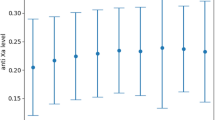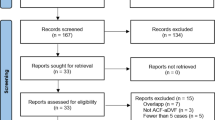Abstract
Background
In 2014, A Randomized Trial of Unruptured Brain Arteriovenous Malformations (ARUBA) concluded that medical management alone for cranial arteriovenous malformations (AVMs) had better clinical outcomes than interventional treatment. The impact of the ARUBA study on changes in the rates of intervention and outcomes is unknown. Thus, we investigated whether the conclusions from ARUBA may have influenced treatment modalities and outcomes of unruptured AVMs.
Methods
The National Inpatient Sample (NIS) was queried between 2006 and 2018, for adult patients with an AVM who were admitted on an elective basis. Interventions included open, endovascular, and stereotactic surgeries. Join-point regression was used to assess differences in slopes of treatment rate for each modality before and after the time-point. Logistic regression was used to assess the odds of non-routine discharge and hemorrhage between the two time-points for each treatment modality. Linear regression was used to assess the mean length of stay (LOS) for each treatment modality between the two time-points.
Results
A total of 40,285 elective admissions for AVMs were identified between 2006 and 2018. The rate of intervention was higher pre-ARUBA (n = 15,848; 63.8%) compared to post-ARUBA (n = 6985; 45.2%; difference in slope − 8.24%, p < 0.001). The rate of open surgery decreased, while endovascular and stereotactic surgeries remained the same, after the ARUBA trial time-point (difference in slopes − 8.24%, p < 0.001; − 1.74%, p = 0.055; 0.20%, p = 0.22, respectively). For admissions involving interventions, the odds of non-routine discharge were higher post-ARUBA (OR 1.24; p = 0.043); the odds of hemorrhage were lower post-ARUBA (OR 0.69; p = 0.025). There was no statistical difference in length of stay between the two time-points (p = 0.22).
Conclusion
The rate of intervention decreased, the rate of non-routine discharge increased, and rate of hemorrhage decreased post-ARUBA, suggesting that it may have influenced treatment practices for unruptured AVMs.

Similar content being viewed by others
References
Baharvahdat H, Blanc R, Fahed R et al (2019) Endovascular treatment for low-grade (Spetzler-Martin I-II) brain arteriovenous malformations. AJNR Am J Neuroradiol 40(4):668–672
Bervini D, Morgan MK, Ritson EA, Heller G (2014) Surgery for unruptured arteriovenous malformations of the brain is better than conservative management for selected cases: a prospective cohort study. Neurochirurgie 60(6):327
Birnbaum LA, Straight M, Hegde S, Lacci JV, de Leonni SM, Mascitelli JR, McDougall CM, Caron J-LR (2020) Microsurgery for unruptured cerebral arteriovenous malformations in the National Inpatient Sample is more common post-ARUBA. World Neurosurg 137:e343–e346
Elhammady MS, Heros RC (2014) Editorial: Surgical management of unruptured cerebral arteriovenous malformations. J Neurosurg 121(4):875–877
Elhammady MS, Heros RC (2017) Editorial: The ARUBA study: where do we go from here? J Neurosurg 126(2):481–485
HCUP Frequently asked questions. https://www.hcup-us.ahrq.gov/tech_assist/faq.jsp. Accessed 4 Apr 2021
HCUP-US NIS Overview. https://www.hcup-us.ahrq.gov/nisoverview.jsp. Accessed 2 May 2020
Heros RC, Korosue K, Diebold PM (1990) Surgical excision of cerebral arteriovenous malformations: late results. Neurosurgery 26(4):570–578
Magro E, Gentric J-C, Darsaut TE, Ziegler D, Bojanowski MW, Raymond J, MSI, (2017) Responses to ARUBA: a systematic review and critical analysis for the design of future arteriovenous malformation trials. J Neurosurg 126(2):486–494
Meling TR, Proust F, Gruber A, Niemela M, Regli L, Roche P-H, Vajkoczy P (2014) On apples, oranges, and ARUBA. Acta Neurochir (Wien) 156(9):1775–1779
Mohr JP, Parides MK, Stapf C et al (2014) Medical management with or without interventional therapy for unruptured brain arteriovenous malformations (ARUBA): a multicentre, non-blinded, randomised trial. The Lancet 383(9917):614–621
Mohr JP, Overbey JR, Hartmann A et al (2020) Medical management with interventional therapy versus medical management alone for unruptured brain arteriovenous malformations (ARUBA): final follow-up of a multicentre, non-blinded, randomised controlled trial. Lancet Neurol 19(7):573–581
Moore BJ, White S, Washington R, Coenen N, Elixhauser A (2017) Identifying increased risk of readmission and in-hospital mortality using hospital administrative data: the AHRQ Elixhauser Comorbidity Index. Med Care 55(7):698–705
Newson RB (2012) Sensible parameters for univariate and multivariate splines. Stata J 12(3):479–504
Producing national HCUP estimates - accessible version. https://www.hcup-us.ahrq.gov/tech_assist/nationalestimates/508_course/508course_2018.jsp. Accessed 13 Dec 2020
Reynolds AS, Chen ML, Merkler AE, Chatterjee A, Díaz I, Navi BB, Kamel H (2019) Effect of a randomized trial of unruptured brain arteriovenous malformation on interventional treatment rates for unruptured arteriovenous malformations. Cerebrovasc Dis 47(5–6):299–302
Statacorp, (2019) Stata statistical software: release 16. StataCorp LLC, College Station, TX
Author information
Authors and Affiliations
Corresponding author
Ethics declarations
Conflict of interest
The authors declare no competing interests.
Additional information
Publisher’s note
Springer Nature remains neutral with regard to jurisdictional claims in published maps and institutional affiliations.
This article is part of the Topical Collection on Vascular Neurosurgery - Arteriovenous
Supplementary Information
Below is the link to the electronic supplementary material.
Rights and permissions
About this article
Cite this article
Wahood, W., Alexander, A.Y., Doherty, R.J. et al. Elective intervention for unruptured cranial arteriovenous malformations in relation to ARUBA trial: a National Inpatient Sample study. Acta Neurochir 163, 2489–2495 (2021). https://doi.org/10.1007/s00701-021-04936-7
Received:
Accepted:
Published:
Issue Date:
DOI: https://doi.org/10.1007/s00701-021-04936-7




